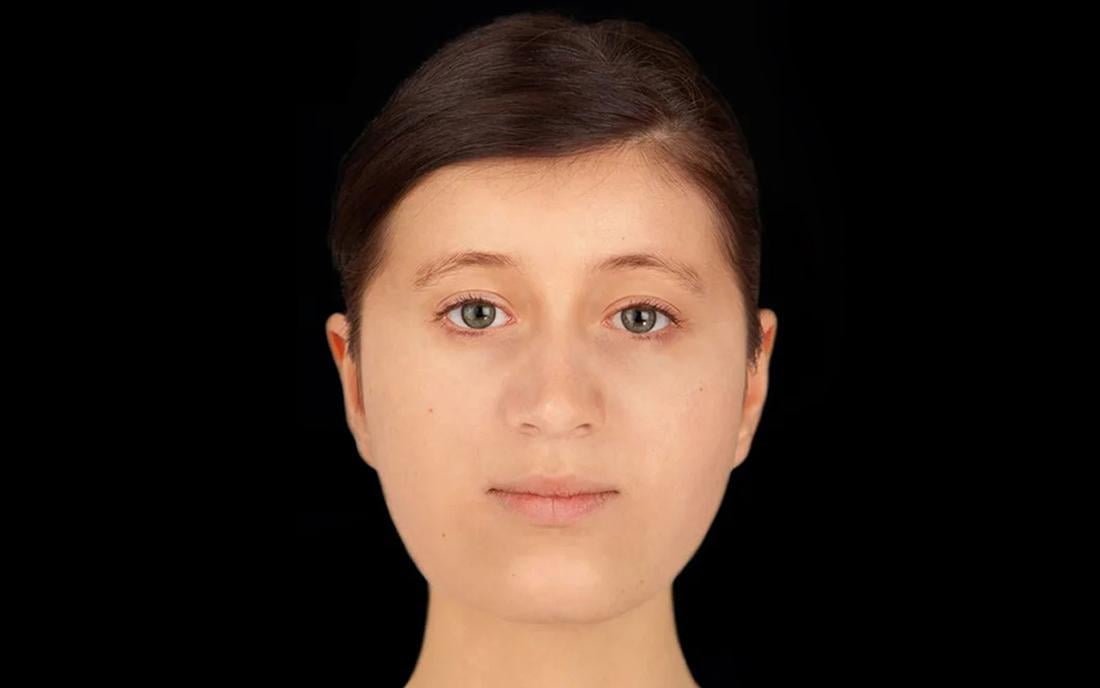The face of a 16-year-old girl buried in the 7th century near Cambridge, UK, has been reconstructed based on the analysis of her skull.
 A facial reconstruction of the “Trumpington girl” found buried near Cambridge in the UK. Credit: Hew Morrison © 2023
A facial reconstruction of the “Trumpington girl” found buried near Cambridge in the UK. Credit: Hew Morrison © 2023
The girl, known as the “Trumpington girl,” was found wearing a rare gold and garnet cross and was buried in a remarkable manner on a carved wooden bed.
The facial reconstruction, created by forensic artist Hew Morrison, reveals a fair face with pale skin, a peтιтe nose, strong cheekbones, and one eye slightly lower than the other.
Although her precise eye and hair color could not be determined without DNA analysis, the reconstruction provides an indication of her appearance before her death.
 The Trumpington Cross was found during an excavation in 2012. Credit: University of Cambridge Archaeological Unit
The Trumpington Cross was found during an excavation in 2012. Credit: University of Cambridge Archaeological Unit
Scientific analysis of the girl’s bones and teeth conducted by bioarchaeologists Dr. Sam Leggett and Dr. Alice Rose, along with archaeologist Dr. Emma Brownlee, showed that she migrated from Central Europe to England as a young girl, possibly from southern Germany near the Alps.
Isotopic analysis also indicated that her diet changed significantly once she arrived in England, with a decrease in the proportion of protein. This change occurred close to the end of her life, suggesting a tragic and short period between her migration and burial.
The Trumpington girl’s ornate cross, made of gold and garnets, suggests that she belonged to the aristocracy or even royalty. The cross is one of only five of its kind ever found in Britain, and it identifies her as one of England’s earliest converts to Christianity.
The presence of the cross in her grave raises questions about her potential role in the early Christian church. The burial site where she was discovered is one of 18-bed burials found in the UK and is ᴀssociated with high-status women during the early Anglo-Saxon period.
Dr. Leggett speculated that the Trumpington girl was part of an elite group of women who traveled from mainland Europe, possibly Germany, in the 7th century. The lifestyle change reflected in her diet suggests that her movement to England may have resulted in significant lifestyle changes.
The exhibition at the Museum of Archaeology and Anthropology at the University of Cambridge showcases the Trumpington Cross, delicate gold and garnet pins, and the burial bed’s decorative headboard, shedding light on the lives of people during pivotal moments in Cambridgeshire’s history.
The mysteries surrounding the Trumpington girl continue to intrigue researchers and historians. Further DNA analysis is being conducted to potentially reveal more details about her, such as her hair and eye color and any possible infections or genetic diseases she may have had.
The ongoing research aims to shed light on the importance of women and girls in the early medieval world, particularly within the Christian Church, and their power and significance in society during the 7th century.
The Trumpington girl’s burial site remains an area of interest for researchers, who aim to understand why she was buried near Cambridge and the significance of the region during that time.
The 7th century is a period with limited historical documentation, and there is much more to discover about this era. The exhibition provides an opportunity to explore the archaeology of the Cambridge region and learn from the Trumpington girl’s burial and artifacts.
The exhibition also allows the public to connect with the girl’s story and visualize her as a living person rather than an enigma of the past.





